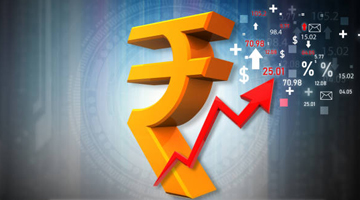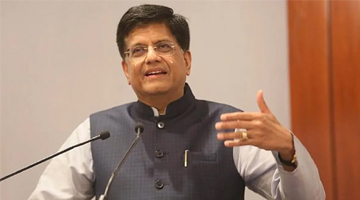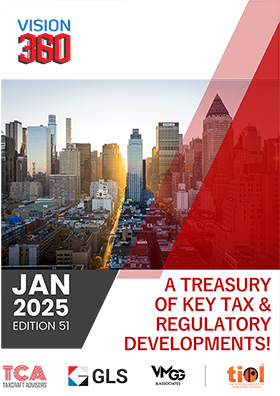World Bank forecasts 6.7% growth for India
By TIOL News Service
NEW DELHI, JAN 20, 2025: INDIA is set to dominate the global economic landscape, maintaining its status as the fastest-growing large economy for the next two fiscal years . The January 2025 edition of the World Bank's Global Economic Prospects (GEP) report projects India's economy to grow at a steady rate of 6.7% in both FY26 and FY27, significantly outpacing global and regional peers. At a time when global growth is expected to remain at 2.7 per cent in 2025-26, this remarkable performance underscores India's resilience and its growing significance in shaping the world's economic trajectory.
The GEP report credits this extraordinary momentum to a thriving services sector and a revitalised manufacturing base, driven by transformative government initiatives. From modernising infrastructure to simplifying taxes, these measures are fuelling domestic growth and positioning India as a cornerstone of global economic stability. With its closest competitor, China, decelerating to 4 per cent growth next year, India's rise is more than just a statistic. It is a powerful story of ambition, innovation, and unmatched potential.
Complementing the World Bank report, the latest update from the International Monetary Fund's (IMF) World Economic Outlook (WEO) also reinforces India's strong economic trajectory. The IMF forecasts India's growth to remain robust at 6.5% for both 2025 and 2026, aligning with earlier projections from October. This consistent growth outlook reflects India's stable economic fundamentals and its ability to maintain momentum despite global uncertainties. The continued strength of India's economic performance, as projected by both the World Bank and IMF, underscores the country's resilience and highlights the sustained strength of its economic fundamentals, making India a crucial player in the global economic landscape.
Overview of World Bank's GEP Report
The Global Economic Prospects (GEP) report is a flagship publication of the World Bank Group that examines trends and projections in the global economy. It places a special emphasis on emerging markets and developing economies, offering insights into their growth trajectories and challenges. Published twice a year in January and June, the report serves as a vital resource for policymakers, economists, and researchers. The January edition delves into detailed analyses of pressing policy issues, while the June edition provides shorter, focused analytical pieces.
The latest GEP report marks a significant milestone by offering the first comprehensive review of the performance of developing economies since the beginning of the 21st century. With 2025 signalling the end of its first quarter, the report assesses the progress made by these economies since 2000 and evaluates their future prospects over the next 25 years. This edition features two analytical chapters. One examines the opportunities and challenges faced by middle-income emerging and developing economies, while the other focuses on the progress and hurdles of the world's poorest nations.
Key Findings in January 2025 Report
India is projected to remain the fastest-growing large economy for FY26 and FY27, reaffirming its dominance in the global economic landscape.
India's economy is expected to grow at a stable rate of 6.7 per cent annually during FY26 and FY27.
Growth in India's services sector is expected to remain robust, while manufacturing activity will strengthen, supported by government efforts to improve logistics infrastructure and streamline tax systems.
Private consumption in India is likely to gain momentum, driven by a stronger labour market, increased access to credit, and lower inflation.
India's Investment growth is expected to remain steady, supported by rising private investments, improved corporate balance sheets, and favourable financing conditions.
Global economic growth is projected to hold steady at 2.7 per cent in 2025-26, highlighting India's outperformance.
Emerging Market and Developing Economies (EMDEs) have undergone significant transformation since 2000, now contributing about 45 per cent of global GDP, compared to 25 per cent at the start of the century.
India, China, and Brazil, the three largest EMDEs, have collectively driven approximately 60 per cent of annual global growth since the start of the century.
Government Schemes and Initiatives Driving Growth
Government of India has implemented a series of visionary schemes and initiatives aimed at propelling the nation towards sustained economic growth and global leadership. From infrastructure development under the PM GatiShakti National Master Plan to fostering innovation through initiatives like Startup India and the Production Linked Incentive Scheme, these reforms are transforming sectors such as manufacturing, digital economy, and financial inclusion. Collectively, they reflect India's commitment to building a resilient, self-reliant, and globally competitive economy.
Conclusion
India's remarkable economic trajectory is a testament to its vision of inclusive growth and innovation-driven development. By implementing forward-thinking policies, fostering a robust infrastructure, and embracing digital transformation, the nation is redefining its global standing. As the fastest-growing large economy, with steady growth projected at 6.7% over the next two fiscal years, India continues to outpace global peers and cement its position as a leader in economic resilience and progress. From the Goods and Services Tax unifying the market to initiatives like Startup India and the Production Linked Incentive Scheme bolstering entrepreneurship and manufacturing, the nation is building a dynamic and robust economy. With this momentum, India is set to shape the future of the global economy, exemplifying the power of ambition, resilience, and strategic governance in achieving unparalleled progress.















